Papers by SUPANEE THANAKUN
International Journal of Environmental Research and Public Health
This article is an open access article distributed under the terms and conditions of the Creative... more This article is an open access article distributed under the terms and conditions of the Creative Commons Attribution (CC BY
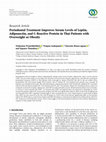
International Journal of Dentistry
Periodontitis and overweight or obesity independently change serum levels of leptin, adiponectin,... more Periodontitis and overweight or obesity independently change serum levels of leptin, adiponectin, and C-reactive protein (CRP). The aim of this study is to investigate the alterations of serum levels of leptin, adiponectin, and CRP after nonsurgical periodontal treatment (NSPT) in Thai patients with overweight or obesity (Owt/Ob) who did or did not exhibit severe periodontitis (SP) and normal weight (Nwt) patients with or without SP. Two hundred sixty patients were screened; 29 patients were included in this study. The study participants comprised 6 patients with Owt/Ob who exhibited SP, 11 patients with Owt/Ob who did not exhibit SP, 5 Nwt patients with SP, and 7 Nwt patients without SP. Periodontal disease status was evaluated; serum levels of leptin, adiponectin, and CRP were determined by enzyme-linked immunosorbent assay at baseline, as well as at 3 and 6 months after NSPT. At 3 months after NSPT, periodontal status was improved in all groups ( p
PLOS ONE
Objective Interleukin (IL)-17A and IL-18 have been proposed to play important roles in periodonti... more Objective Interleukin (IL)-17A and IL-18 have been proposed to play important roles in periodontitis and type 2 diabetes mellitus (DM), but human data are conflicting. The present study aimed to investigate the roles of IL-17A and IL-18 in periodontitis and DM by measuring salivary and serum levels, respectively.
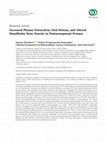
International Journal of Dentistry
An association between oral diseases and postmenopausal status has been recognized. However, the ... more An association between oral diseases and postmenopausal status has been recognized. However, the relationship between all oral disease, mandibular bone density, health status, and osteocalcin (OCN) bone markers in postmenopausal dental patients has not been reported. This study was therefore to verify the differences in plasma OCN levels, dental, periodontal, and oral mucosal disease, and mandibular bone density alterations from panoramic radiograph and systemic parameters in postmenopausal women, compared to premenopausal women. Oral, radiographic, and blood examination were performed in 92 females. Dental, periodontal, and oral mucosal statuses were recorded. Health profile parameters were collected from medical charts. Plasma OCN was evaluated by enzyme-linked immunosorbent assay. Forty-two (45.7%) participants were postmenopausal with a higher median age (55 (51, 62) years) than the premenopausal group (43 (38, 45) years). Overweight or obesity, hypercholesterolemia, and impaire...
Journal of Oral Biosciences
Journal of Oral Biosciences

PLOS ONE, 2016
The association between clinically diagnosed periodontitis, a common chronic oral infection, and ... more The association between clinically diagnosed periodontitis, a common chronic oral infection, and metabolic syndrome has been previously reported. The aim of this study was to investigate the association of plasma IgG levels against Aggregatibacter actinomycetemcomitans, Porphyromonas gingivalis, and Prevotella intermedia, C-reactive protein, and periodontal status with metabolic syndrome. Plasma IgG levels and C-reactive protein were measured by enzyme-linked immunosorbent assay, and salivary levels of A. actinomycetemcomitans and P. gingivalis were determined by quantitative real-time polymerase chain reaction. Among 127 individuals aged 35-76 years, 57 participants had metabolic syndrome and severe periodontitis, 25 had metabolic syndrome and an absence of severe periodontitis, 17 healthy individuals had severe periodontitis, and 28 healthy individuals were without severe periodontitis. Patients with metabolic syndrome had reduced humoral immune response to A. actinomycetemcomitans (p = 0.008), regardless of their salivary levels or periodontitis status compared with healthy participants. The IgG antibody response to P. gingivalis, regardless of their salivary levels or participants' health condition, was significantly higher in severe periodontitis patients (p<0.001). Plasma IgG titers for P. intermedia were inconsistent among metabolic syndrome or periodontal participants. Our results indicate that the presence of lower levels of IgG antibodies to A. actinomycetemcomitans (OR = 0.1; 95%CI 0.0-0.7), but not P. gingivalis, a severe periodontitis status (OR = 7.8; 95%CI 1.1-57.0), high C-reactive protein levels (OR = 9.4; 95%CI 1.0-88.2) and body mass index (OR = 3.0; 95%CI 1.7-5.2), are associated with the presence of metabolic syndrome. The role of the decreased IgG antibody response to A. actinomycetemcomitans, increased C-reactive protein levels on the association between periodontal disease and metabolic syndrome in a group of Thai patients is suggested.
Journal of Periodontology, 2015
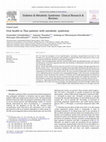
Metabolic syndrome (MS) is a group of interrelated components that predispose individual to incre... more Metabolic syndrome (MS) is a group of interrelated components that predispose individual to increased risk for type2 diabetes mellitus (DM) and cardiovascular disease (CVD). The International Diabetes Federation (IDF) has proposed a definition of MS in order to use for clinical practice and epidemiologic studies [1]. Central obesity, determined by waist circumference, is a prerequisite criterion for the diagnosis of the MS. The minimal waist circumference varies from 90 to 102 centimeters (cm) in males and from 80 to 88 cm in females depending on ethnic group [1]. The MS can be diagnosed when central obesity plus any two of the following four factors are present. These include raised triglycerides (TG) level (!150 mg/dL, or specific treatment for this lipid abnormality), reduced high density lipoprotein cholesterol (HDL-C) (<40 mg/dL in males, and <50 mg/dL in females, or specific treatment for this lipid abnormality), or raised blood pressure (BP) (systolic BP ! 130 or diastolic BP ! 85 mmHg, or treatment of previously diagnosed hypertension) and raised fasting plasma glucose (FPG) (!100 mg/dL, or previously diagnosed type2 DM) [1]. In Thailand, the prevalence of MS varies from 15 to 20% among various population groups which is comparable to those in developed countries [2-4]. Many drugs used in the treatment of MS can affect salivation and may induce oral complications such as glossitis, oral candidiasis, dental caries and some drugs have been reported to induce oral lichenoid reactions [5-8]. Moreover, high prevalence of candidiasis, denture stomatitis and periodontitis has been reported in patients with DM, a component of MS [9-13]. Therefore, we aimed to study the prevalence of oral manifestations, xerostomia, hyposalivation and level of oral microflora in a group of Thai patients with MS and to determine if there is any association between MS and these oral health components.

Atrophic-erosive form of oral lichen planus can cause severe pain and involve multiple sites in o... more Atrophic-erosive form of oral lichen planus can cause severe pain and involve multiple sites in oral cavity. Because of its recalcitrant nature, patients with long-term systemic corticosteroid management commonly reported adverse effects. Therefore, the potent topical steroid, dexamethasone mouthrinse may be suitable and effective. Objectives: To evaluate the cytotoxicity of the developed dexamethazone mouthrinse produced by Faculty of Dentistry, Mahidol University on keratinocyte and fibroblast cultured-cells using MTT assay. Methods: The test cells were keratinocytes (NOK cells) and fibroblast cells (L929). Monolayer (1x105 cells/ml) of each test cells was used to test in a 96-well tissue-culture plate. After incubation at 37 degrees C in 5% CO2 for 24 hr in the presence of various concentrations of the dexamethasone mouthrinse (0.01%, 0.005%, 0.0025%, 0.00125%, 0.001% and 0.0004%), cell survival was determined using MTT assay. Results: At the same levels of concentrations of 0.01...
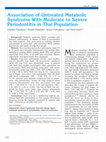
Journal of Periodontology, 2014
Background: Metabolic syndrome (MetS) correlates with systemic inflammation. A relation of MetS t... more Background: Metabolic syndrome (MetS) correlates with systemic inflammation. A relation of MetS to periodontitis has been reported. This study aims to evaluate whether periodontitis is associated with untreated MetS, plasma adiponectin, and leptin among Thai people. Methods: One hundred twenty-five participants (aged 35 to 76 years) were recruited. Demographic and biologic data, bleeding on probing (BOP), probing depth (PD), and clinical attachment level (CAL) of all teeth were examined. Plasma adiponectin and leptin levels were measured. Results: Forty-four participants (35.2%) were healthy, and 81 (64.8%) had MetS. All periodontal conditions (BOP, PD, and CAL) were significantly worse in patients with MetS than healthy participants. After adjustment for confounders, MetS was strongly associated with severe periodontitis (odds ratio [OR] = 3.60, 95% confidence interval [CI]: 1.34 to 9.65). MetS with four to five components had a higher association with periodontitis than did MetS with three components (OR = 5.49, 95% CI: 1.75 to 17.19), whereas each separate component had no association with periodontitis, except for high diastolic blood pressure. Periodontitis was also associated with age (OR = 1.08, 95% CI: 1.01 to 1.14) and education (OR = 3.76, 95% CI: 1.05 to 13.40). The risk of MetS was predicted by body mass index and plasma adiponectin (OR = 1.90, 95% CI: 1.24 to 2.92 and OR = 0.93, 95% CI: 0.88 to 0.98, respectively). Conclusions: There may be a relationship between untreated MetS and periodontitis in Thai people. Periodontal diagnosis should be regularly conducted in patients with MetS.

Peptides, 2013
The recovery of protein from saliva has been extensively investigated as a method to monitor heal... more The recovery of protein from saliva has been extensively investigated as a method to monitor health. The aim of this study was to compare filtration and centrifugation as two methods of saliva processing necessary for determining the levels of salivary leptin and adiponectin. Thirty-seven healthy patients (median age of 45 years; range 35-73) participated in the study. Unstimulated whole saliva was collected by a drooling technique. An aliquot was filtered using a Millex-Millipore(®) (0.45μm PVDF Dura Pore membrane) syringe and a second aliquot was centrifuged at 15000×g for 15min at 4°C. Leptin and adiponectin levels were analyzed using an ELISA kit for serum (RayBio(®), GA, USA) with minor modifications. Leptin and adiponectin levels following the filtration technique yielded comparable results with those after centrifugation. Correlation was observed between filtered and centrifuged salivary leptin levels ((r=0.9155; 95% CI 0.8362-0.9573; p&lt;0.0001) with concordance correlation coefficient k 0.9114 (95% CI 0.8332-0.9539)). Less correlation was observed for adiponectin ((r=0.5718; 95% CI 0.3041-0.7558; p=0.0002) with concordance correlation coefficient k 0.5586 (95% CI 0.2977-0.7419)). Using a Bland-Altman plot, similar measurements for both adipocytokines were observed with mean difference within a 95% CI, and interpreted as no systematic differences between the two processing techniques. This study showed that filtration is an alternative saliva processing technique to retrieve supernatant for protein analysis. Filtered saliva yielded leptin and adiponectin concentrations comparable with those obtained from centrifuged saliva.
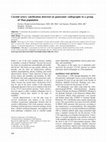
Oral Surgery, Oral Medicine, Oral Pathology, Oral Radiology, and Endodontology, 2006
Objective. To determine the prevalence of carotid artery calcification (CAC) detected on panorami... more Objective. To determine the prevalence of carotid artery calcification (CAC) detected on panoramic radiographs in a Thai population. Study design. The panoramic radiographs of the patients 50 and older (N = 1,370) visiting Mahidol University from January 1998 through September 2004 were retrospectively reviewed for CAC. The medical records of the positive subjects were then reviewed. Results. Thirty-four (2.5%) of the 1,370 patients, 16 men and 18 women, with a mean age of 69 and a range of 50 to 87 years, had 1 or more CACs. These calcifications were unilateral in 25 (73.5%) and bilateral in 9 (26.5%) subjects. Of those positive subjects, 18 reported hypertension, 10 reported diabetes mellitus, and 5 reported hyperlipidemia. Conclusions. Although it is uncommon to find CAC in the Thai population, dentists should be aware of this calcification on the routine panoramic radiographs and promptly refer for cerebrovascular and cardiovascular evaluation.
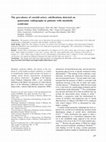
Oral Surgery, Oral Medicine, Oral Pathology, Oral Radiology, and Endodontology, 2009
The purpose of this study was to determine the prevalence of carotid artery calcifications (CAC) ... more The purpose of this study was to determine the prevalence of carotid artery calcifications (CAC) detected on panoramic radiographs in patients with metabolic syndrome (MetS). Study design. Eighty-five Thai subjects (29 men, 56 women) who had MetS according to the International Diabetes Federation definition were evaluated for CAC detected on panoramic radiographs. The confirmation of findings was done by ultrasonography. Results. Carotid artery calcifications were detected in 19 subjects (22.4%) with a mean age of 64 years, range 48-74 years. These subjects included 12 men and 7 women. The CAC were significantly more common in men than in women (P ϭ .002). There were 8 subjects (9.4%) with bilateral calcifications and 11 subjects (12.9%) with unilateral calcification. No significant difference between the right and left sides was found (P ϭ .44). Conclusion. Thai people with MetS have high prevalence of radiographically detectable carotid artery calcifications. (Oral Surg Oral Med Oral Pathol Oral Radiol Endod 2009;108:e57-e62)
Oral Radiology, 2011
Objective To determine the sensitivity and specificity of panoramic radiography in detecting car... more Objective To determine the sensitivity and specificity of panoramic radiography in detecting carotid atheromas in patients with metabolic syndrome (MetS) by comparing ultrasonographic findings. Methods Panoramic radiography and ultrasonography were performed in 85 MetS patients to determine the presence of carotid atheroma. The panoramic radiographic findings were classified into calcified plaque and no calcified plaque. The ultrasonic findings were divided into four
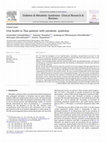
Diabetes & Metabolic Syndrome: Clinical Research & Reviews, 2009
Metabolic syndrome (MS) is a group of interrelated components that predispose individual to incre... more Metabolic syndrome (MS) is a group of interrelated components that predispose individual to increased risk for type2 diabetes mellitus (DM) and cardiovascular disease (CVD). The International Diabetes Federation (IDF) has proposed a definition of MS in order to use for clinical practice and epidemiologic studies [1]. Central obesity, determined by waist circumference, is a prerequisite criterion for the diagnosis of the MS. The minimal waist circumference varies from 90 to 102 centimeters (cm) in males and from 80 to 88 cm in females depending on ethnic group [1]. The MS can be diagnosed when central obesity plus any two of the following four factors are present. These include raised triglycerides (TG) level (!150 mg/dL, or specific treatment for this lipid abnormality), reduced high density lipoprotein cholesterol (HDL-C) (<40 mg/dL in males, and <50 mg/dL in females, or specific treatment for this lipid abnormality), or raised blood pressure (BP) (systolic BP ! 130 or diastolic BP ! 85 mmHg, or treatment of previously diagnosed hypertension) and raised fasting plasma glucose (FPG) (!100 mg/dL, or previously diagnosed type2 DM) [1]. In Thailand, the prevalence of MS varies from 15 to 20% among various population groups which is comparable to those in developed countries [2-4]. Many drugs used in the treatment of MS can affect salivation and may induce oral complications such as glossitis, oral candidiasis, dental caries and some drugs have been reported to induce oral lichenoid reactions [5-8]. Moreover, high prevalence of candidiasis, denture stomatitis and periodontitis has been reported in patients with DM, a component of MS [9-13]. Therefore, we aimed to study the prevalence of oral manifestations, xerostomia, hyposalivation and level of oral microflora in a group of Thai patients with MS and to determine if there is any association between MS and these oral health components.
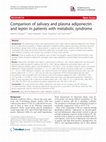
Background: The relationship of saliva with plasma protein levels makes saliva an attractive diag... more Background: The relationship of saliva with plasma protein levels makes saliva an attractive diagnostic tool. Plasma levels of adiponectin and leptin in healthy individuals or diabetes mellitus patients have been previously reported. Nevertheless, salivary levels of these adipocytokines in patients with metabolic syndrome (MS) have never been investigated. This study was aimed to determine adiponectin and leptin levels in saliva and plasma from patients with metabolic syndrome, and evaluate any correlation of these levels with MS. Methods: Forty-six healthy and 82 MS patients were enrolled. Demographic data and blood biochemistries were recorded. Saliva and plasma adiponectin and leptin levels were analyzed by enzyme-linked immunosorbent assay (ELISA). Results: Adiponectin and leptin were higher in plasma than in saliva (p < .001). Plasma adiponectin was decreased and plasma leptin increased in patients with MS (p < .001). Salivary adiponectin and salivary leptin were not different between healthy subjects and MS patients (p = .619 and p = .523). Correlation between salivary and plasma adiponectin showed significant association (r = .211, p = .018) while salivary and plasma leptin had no correlation (r = −.161, p = .069). Significant correlation was observed between the salivary adiponectin/salivary leptin ratio and plasma adiponectin (r = .371, p < .001), but not with any component of MS. Increased triglyceride and waist circumference were associated with risk of having a low level of plasma adiponectin (OR = 1.009; 95% CI 1.002-1.015 and OR = 1.125; 95% CI 1.029-1.230). For leptin, body mass index and high-density lipoprotein cholesterol (HDL-C) were associated with a high level of plasma leptin (OR = 1.621; 95% CI 1.212-2.168 and OR = .966; 95% CI .938-.996). The OR for MS as predicted by plasma adiponectin was .928 (95% CI .881-.977). Conclusions: This study showed that salivary adiponectin and leptin do not correlate with MS. Although correlation between salivary and plasma adiponectin was observed, no association with MS was observed. Only plasma adiponectin may be useful for the prediction of MS.
Uploads
Papers by SUPANEE THANAKUN